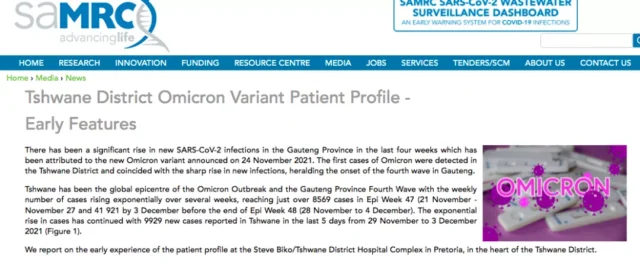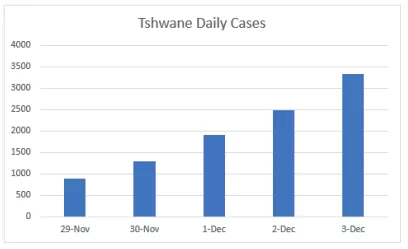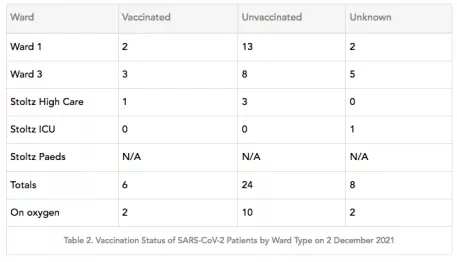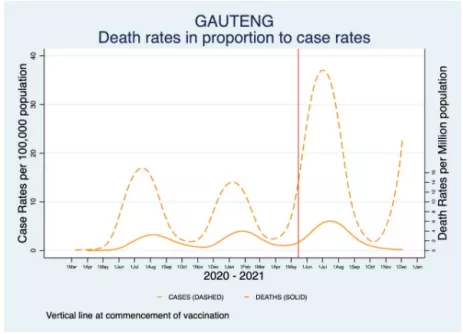SAMRC: The first report about the risk of Omicron mutant strains
- Normal Liver Cells Found to Promote Cancer Metastasis to the Liver
- Nearly 80% Complete Remission: Breakthrough in ADC Anti-Tumor Treatment
- Vaccination Against Common Diseases May Prevent Dementia!
- New Alzheimer’s Disease (AD) Diagnosis and Staging Criteria
- Breakthrough in Alzheimer’s Disease: New Nasal Spray Halts Cognitive Decline by Targeting Toxic Protein
- Can the Tap Water at the Paris Olympics be Drunk Directly?
SAMRC: The first report about the risk of Omicron mutant strains
- Should China be held legally responsible for the US’s $18 trillion COVID losses?
- CT Radiation Exposure Linked to Blood Cancer in Children and Adolescents
- FDA has mandated a top-level black box warning for all marketed CAR-T therapies
- Can people with high blood pressure eat peanuts?
- What is the difference between dopamine and dobutamine?
- How long can the patient live after heart stent surgery?
SAMRC: The first report about the risk of Omicron mutant strains.
The first report reveals the risk of Omicron mutant strains: the number of cases has increased sharply, showing a younger age, but the death rate and severe disease rate have not yet risen.
Guide
The COVID-19 Omicron mutant is coming fiercely. Is it a big boss, or are we exaggerating it?
Recently, there is finally a clinical analysis report that reveals its true side. The clinical data comes from the source of the Omicron epidemic-Gauteng Province, South Africa.
On December 4, a doctor in Gauteng Province, South Africa released the first research report on the Omicron mutant of the COVID-19, Gauteng Province is the epicenter of the COVID-19 Omicron epidemic.
This report found that the number of patients with COVID-19 pneumonia in a local hospital in Gauteng Province has increased sharply, but the severe disease rate and mortality rate are not higher than Delta.
Studies believe that it takes a longer time to make objective judgments in this regard. At the same time, the proportion of children’s infections has indeed risen.
Since the “strongest” COVID-19 mutant strain B.1.1529 (Omicron strain) was first published on November 24, it has attracted global attention because its spike protein carries a large number of mutations, and the first case of Omicron has been found in South Africa.
Since the case, the number of local COVID-19 infection cases has risen sharply, making the outside world worry about whether it is the strongest strain of COVID-19 virus ?
According to the latest news, Hong Kong has confirmed the fourth case of Omicron mutant infection.
Fortunately, he only stayed in the restricted area of the airport and did not spread to the community.
Nearly 250 cases of Omicron mutant infections have also been found in the UK.
According to statistics from the World Health Organization, Omicron mutants have appeared in at least 38 countries or regions around the world.
At present, the COVID-19 Omicron mutant has spread rapidly in the United States, and the United States is likely to become the epicenter of a new round of Omicron mutant invasion after South Africa.
At present, a total of one-third of the states in the United States have the Omicron strain.
If it is not controlled in time, a large-scale community infection is inevitable.

Major media pay close attention to the development of Omicron mutants
On December 4th, Fareed Abdullah , Director of the Office of AIDS and Tuberculosis Research of the South African Medical Research Council (SAMRC) , through the analysis of the Steve Biko Hospital/Tswann District Hospital in Gauteng The number of COVID-19 infection cases revealed for the first time how strong the Omicron mutant is, whether it will cause severe illness, and how high the proportion is.
Abdullah is also a part-time AIDS clinician in this hospital in Gauteng Province. After the outbreak, he has been engaged in clinical research on COVID-19 pneumonia.

Farid Abdullah, image courtesy of Masa Losi/NSP Review

A preliminary clinical report on the Omicron strain issued by the South African Medical Research Council
According to the data in this report, on December 2, there were more than 10,000 new confirmed cases in a single day in South Africa, and Gauteng became the hardest-hit area.
Currently, Gauteng Province is experiencing the fourth wave of epidemics (previously Alpha, Beta strains, Delta strains, and now Omicron strains) .
The northern city of Gauteng, Pretoria (Tshwane), has been the epicenter of the Omicron epidemic and the epidemic in Gauteng.
In recent weeks, the number of COVID-19 cases infected every week in Pretoria has been increasing exponentially.
In the 47th week, from November 21st to 27th, there were 8569 new cases of COVID-19 cases, and the 48th week was November 29th.
In the five days to December 3, 9,929 new cases were reported in Pretoria.
 From November 29 to December 3, the number of new cases of COVID-19 pneumonia added daily, the number of new cases increased every day, the picture is from sacronavirus.co.za
From November 29 to December 3, the number of new cases of COVID-19 pneumonia added daily, the number of new cases increased every day, the picture is from sacronavirus.co.za
So, what is the specific situation of these infection cases?
According to the province-wide statistics released by Gauteng on December 2, 2021 and the database of the South African National Institute of Infectious Diseases (NICD) , the number of admissions to all public and private hospitals in Pretoria has risen sharply, only on November 14.
Between January and 29, 166 new cases of COVID-19 were admitted, accounting for 45% of all public hospitals and 26% of the total number of admissions to public and private hospitals during the same period.
However, it is not yet confirmed that these newly admitted cases are caused by the new mutant Omicron, but the study of these cases can represent the clinical symptoms caused by the new mutant.
 Patient situation in Gauteng on December 2
Patient situation in Gauteng on December 2
On December 2, 2021, the researchers conducted statistics on oxygen dependence on 42 hospitalized cases of the COVID-19 ward, and showed that 29 of the cases were not dependent on oxygen.
These patients breathed well in the ward and did not find any respiratory symptoms.
The problem is “incidental COVID-19 pneumonia admission”, and most of them are admitted to the hospital with other medical or surgical diseases.
In addition, 13 cases required oxygen inhalation treatment, which combined various symptoms, clinical signs, CXR and inflammation indicators, and 9 of these 13 cases were diagnosed as requiring oxygen inhalation due to COVID-19 pneumonia.
That is, approximately 21% of COVID-19 pneumonia cases require oxygen inhalation, which is lower than the previous epidemic.
In the first three waves of the epidemic, the vast majority of local patients with COVID-19s required oxygen, and those cases that did not require oxygen were basically patients in the recovery period or waiting to be discharged from the hospital.
Previously, experts judged whether the new coronavirus strain caused severe illness by inhaling oxygen. It can be seen that the Omicron strain is currently not as scary as imagined.
On December 5, Anthony Fauci , the chief epidemiological consultant of the United States , stated that the early signs of symptoms caused by the Omicron strain were “a little encouraging.” At the same time, he also warned that “we need more information.”
 Vaccination status of patients with COVID-19 pneumonia admitted to the hospital in Gauteng
Vaccination status of patients with COVID-19 pneumonia admitted to the hospital in Gauteng
As for whether the Omicron strain will greatly reduce the effectiveness of vaccination.
The report pointed out that of the 38 adults in the COVID-19 pneumonia area, 6 of them received the vaccine, 24 were not vaccinated, and 8 did not know the vaccination status.
Previously, the COVID-19 virus was a greater threat to middle-aged and elderly people.
Among the patients with COVID-19 pneumonia admitted this time, 80% are people under 50 years old, 28% are people 30-39 years old, and 19% are children 0-9 years old.
Preliminary data shows that the Omicron strain may make infected people younger. There are also reports that children are susceptible to the Omicron strain, which is different from other new coronavirus strains.
 New cases and deaths in Gauteng in 4 rounds of COVID-19
New cases and deaths in Gauteng in 4 rounds of COVID-19
The above figure shows the 4 rounds of COVID-19 in Gauteng Province, the growth of COVID-19 cases (dotted line) and deaths (solid line) .
The vertical red line is the time for large-scale vaccinations against COVID-19.
According to current trends, it is expected that the Omicron strain will cause a surge in local COVID-19 cases, but whether it will cause a large number of deaths is still unclear, but according to the data obtained this time: the number of hospital admissions has surged in the past two weeks to 166, but the death toll is 10 people, accounting for 6.6%, and this hospital in the past 18 hospitals, the death toll accounted for 18% of the inpatients.
In other words, at least for now, the Omicron strain has not caused a rise in local mortality, although the number of new cases is indeed increasing rapidly.
However, the report also pointed out that the death rate data is difficult to be seen within two weeks, and it will take longer to calculate objectively.
In addition, in terms of the proportion of severely ill patients, only 2 of the 166 hospitalized in the past two weeks were admitted to the ICU, and there were also 3 patients with severe pneumonia.
Finally, this report pointed out that most patients with COVID-19 pneumonia did not know that they had COVID-19 pneumonia when they were admitted to the hospital, and they were more often admitted to the hospital because of complications of COVID-19 pneumonia.
Compared with the previous three waves of epidemics, this round of epidemics has caused a small proportion of patients with COVID-19 pneumonia who need oxygen.
In addition, the patients admitted to the hospital in this round of the epidemic are younger than the previous three times.
Of course, whether it will lead to a higher death rate and severe illness rate, we still need more data.
After reading this report, are we “somewhat encouraging” like Fauci, perhaps the Omicron strain is not so terrible?
SAMRC: The first report about the risk of Omicron mutant strains.
(source:internet, reference only)
Disclaimer of medicaltrend.org
Important Note: The information provided is for informational purposes only and should not be considered as medical advice.



